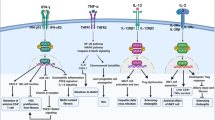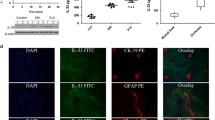Summary
It is evident that hepatic fibrogenesis is a complex process involving a cascade of cytokines which interact to enhance the expression of ECM. Cytokines involved early in this cascade may serve as proinflammatory agents or as stimulators of macrophage and Ito cell activation and proliferation, while those cytokines involved later in this process may be directly fibrogenic. Furthermore, we speculate that a balance between profibrogenic and antifibrogenic cytokines normally exists but in the presence of hepatic insults, a relative superabundance of the fibrogenic factors promotes the development of liver fibrosis. To date, most of the evidence supporting a role for cytokines in liver fibrosis has been obtained inin vitro systems or in animal models. We now need to extend these findings to man in order to determine whether a similar cascade of cytokines is important in the development of this pathologic process in man. Further delineation of these cytokines (as well as other profibrogenic soluble factors), and the mechanisms by which they act, are critical to our development of more rational forms of therapy for liver fibrosis.
Similar content being viewed by others
References
Shuppan D. Structure of the extracellular matrix in normal and fibrotic liver: Collagens and glycoproteins. Sem in Liver Dis 1990;10:l-10.
Weiner FR, Czaja MJ, Giambrone MA, et al. Transcriptional and post transcriptional effects of dexamethasone in murine schistosomiasis. Biochemistry 1987;26:1557–1562.
Maher JJ, McGuire RF. Extracellular matrix gene expression increases preferentially in rat lipocytes and sinusoidal endothelial cell during hepatic fibrosis in vivo. J Clin Invest 1990;86:1641–1648.
Milani S, Herbst H, Schuppan D, et al. In situ hydridization for procollagen type I, III, and IV mRNA in normal and fibrotic rat liver: evidence for predominant expression in non parenchymal liver cells. Hepatology 1989;10:84–92.
Weiner FR, Shah A, Biempica L, et al. The effect of hepatic fibrosis on Ito cell gene expression. Matrix 1992;12:36–43.
Maruyama K, Fienman L, Fainko M. Mammalian collagenase increases in early alcoholic liver disease and decreases with cirrhosis. Life Science 1982;30:1379–1384.
Weiner FR, Blaner WS, Czaja MJ, et al. Ito cell expression of a nuclear retinoic acid receptor. Hepatology 1992;15:336–342.
Davis B, Pratt B, Madri J. Retinol and extracellular collagen matrices modulate hepatic Ito cell collagen phenotype and cellular retinol binding levels. J Biol Chem 1987;262:10280–10286.
Czaja MJ, Weiner FR, Takahashi S, et al. Gamma-interferon treatment inhibits collagen deposition in murine schistosomiasis. Hepatology 1989;10:975–980.
Wu CH, Donovan CB, Wu GY. Evidence of pretranslational regulation of collagen synthesis by collagen propeptides. J Biol Chem 1986;261:10482–10484.
Nagy P, Schaff F, Lapis K. Immunohistochemical detection of transforming growth factor-beta in fibrotic liver diseases. Hepatology 1991;14:269–273.
Czaja MJ, Weiner FR, Flanders KC, et al. In vitro and in vivo association of transforming growth factor-beta with hepatic fibrosis. J Cell Biol 1989;108:2477–2482.
Weiner FR, Giambrone M-A, Czaja MJ, et al. Ito cell gene expression and collagen regulation. Hepatology 1990;11:111–117.
Raghow R, Gossage D, Seyer J, et al. Transcriptional regulation of type I collagen genes in cultured fibroblasts by a factor isolated from thioacetamide-induced fibrotic rat liver. J Biol Chem 1984; 259:12718–12723.
Sporn M, Roberts A, Wakefield LM, et al. Some recent advances in the chemistry and biology of transforming growth factor-beta. J Cell Biol 1987;105:1039–1045.
Braun L, Mead JE, Panzica M, et al. Transforming growth factorbeta mRNA increases during liver regeneration: A possible paracrine mechanism of growth regulation. Proc Natl Acad Sci USA 1988;85:1539–1543.
Sporn MB, Roberts AB, Wakefield LM, et al. Transforming growth factor-beta biological function and chemical structure. Science 1986;233:532–534.
Matsuoka M, Tsukamoto H. Stimulation of hepatic lipocyte collagen production by Kupffer cell-deprived transforming growth factor-beta: implication for a pathogenetic role in alcohol liver fibrogenesis. Hepathology 1990;11:599–605.
Weiner FR, Shah A, Czaja MJ, et al. Effect of transforming growth factor-beta on Ito cell extracellular matrix gene expression. Hepatology 1989;10:682A.
Gressner AM, Bachern MG. Cellular sources of noncollagenous matrix proteins: Role of fat-storing cells in fibrogenesis. Sem in Liver Dis 1990;10:30–46.
Friedman SL. Cellular sources of collagen and regulation of collagen production in liver. Sem in Liver Dis 1990;10:20–29.
Davis BH. Transforming growth factor-beta responsiveness is modulated by the extracellular collagen matrix during hepatic Ito cell culture. J Cell Physiol 1988;136:547–553.
Matrisian LM, Leroy P, Ruhlmann C, et al. Isolation of the oncogene and epidermal growth factor-induced transin gene: complex control in rat fibroblasts. Mol Cell Biol 1986;6:1679–1686.
Keski-Oja J, Raghow R, Sandey M. Regulation of mRNAs for type-1 plasminogen activator inhibitor, fibronectin, and type I procollagen by transforming growth factor-beta. J Biol Chem 1988;263: 3111–3115.
Nakatsukasa H, Nagy P, Evarts RP, et al. Cellular distribution of transforming growth factor-beta and procollagen types I, III and IV transcripts in carbon tetrachloride-induced rat liver fibrosis. J Clin Invest 1990;85:1883–1843.
Manthey CL, Allen JB, Ellingsworth LR, et al. In situ expression of transforming growth factor-beta in streptococcal cell wallinduced granulomatous inflammation and hepatic fibrosis. Growth Factors 1990;4:17–26.
Annoni G, Weiner FR, Zern MA. Increased transforming growth factor-beta (TGF-beta) gene expression in human liver disease. J Hepatology (In press).
Castilla A, Pricto J, Fausto N. Transforming growth factors-beta and α in chronic liver disease: Effects of alpha interferon therapy. N Engl J Med 1991;324:933–940.
Andus T, Bauer J, Gerok W. Effects of cytokines on the liver. Hepatology 1991;13:364–375.
Armendariz-Borunda J, Seyer JM, Postlethwaite AE, et al. Kupffer cells from carbon tetrachloride-injured rat livers produce chemotactic factors for fibroblasts and monocytes: The role of tumor necrosis factor-α. Hepatology 1991;14:895–900.
Beutler B, Cerami A. Cachectin and tumor necrosis factor as two sides of the same biological coin. Nature 1986;320:584–588.
Larrick JW, Kunkel SL. The role of tumor necrosis factor and interleukin-1 in the immunoinflammatory response. Pharm Res 1988;5:129–139.
Matsuoka M, Pham N-T, Tsukamoto H. Differential effects of interleukin-1, tumor necrosis factor-alpha and transforming growth factor-beta on cell proliferation and collagen formation by cultured fat-storing cells. Liver 1989;9:71–78.
Elias JA, Freundlich B, Adams S, et al. Regulation of human lung fibroblast collagen production by recombinant interleukin-1, tumor necrosis factor, and interferon-gamma. Ann NY Acad Sci 1990;580:233–244.
Solis-Herruzo JA, Brenner DA, Chojkier M. Tumor necrosis factor -alpha inhibits collagen gene transcription and collagen synthesis in cultured human fibroblasts. J Biol Chem 1988;263:5841–5845.
Weiner FR, Shah A, Smith P, et al. Regulation of collagen gene expression in 3T3-L1 cells: Effects of adipocyte differentiation and tumor necrosis factor-alpha. Biochemistry 1989;28:4094–4099.
Munker R, Gasson J, Ogawa M, et al. Recombinant human TNF induces production of granulocyte-monocyte colony stimulating factor. Nature 1986;323:79–82.
Dinarello CA. Interleukin-1. Digestive Disease and Sciences 1988;33:25S-35S.
Daireaux M, Redini F, Loyau G, et al. Effects of associated cytokines (IL-1, TNF-alpha, IFN-gamma and TGF-beta) on collagen and glycosaminoglycan production by cultured human synovial cells. Int J Tissue React 1990;12:21–31.
Zuccali JR, Dinarello CA, Oblon DJ, et al. Interleukin-1 stimulates fibroblasts to produce granulocyte-macrophages colony-stimulating activity and prostaglandin E2. J Clin Invest 1986;77:1857–1863.
Cavalis E. Interleukin-1 has independent effects on DNA and collagen synthesis in cultures of rat calvariae. Endocrinology 1986; 118:74–81.
Mauviel A, Heino J, Kahari VM, et al. Comparative effects of interleukin-1 and tumor necrosis factor-alpha on collagen production and corresponding procollagen mRNA levels in human dermal fibroblasts. J Invest Dermatol 1991;96:243–249.
Wing EJ, Magee DM, Whiteside TL, et al. Recombinant human granulocyte/macrophage colony-stimulating factors enhance monocyte cytotoxicity and secretion of tumor necrosis factor and interferon in cancer patients. Blood 1989;73:643–646.
Kausshansky K, Lin N, Adamson JW, Interleukin-1 stimulates fibroblasts to synthesize granulocyte-macrophage and granulocyte colony-stimulating factors. J Clin Invest 1988;81:92–97.
Lindemann A, Riedel D, Oster W, et al. Granulocyte-macrophage colony-stimulating factor induces interleukin-1 production by human polymorphonuclear neutrophils. J Immun 1988;140:837–839.
Ralph P, Nakoinz I. Stimulation of macrophage tumoricidal activity by the growth and differentiation factor CSF-1. Cell Immunol 1987;14:270–279.
Stanley ER, Chen D-M, Lin H-S. Induction of macrophage production and proliferation by a purified colony stimulating factor. Nature 1978;274:168–170.
Shu-Ling L, Degli-Esposti S, Bartocci A, et al. Macrophage-colony stimulating factor (CSF-1) is produced by Ito cells in vitro and is elevated in an in vivo model of hepatic fibrosis. Hepatology 1989;10:632A.
Degli-Esposti S, Stanley R, Zern MA. Macrophage colony stimulatory factor (CSF-1) content is markedly increased in human liver disease. Hepatology 1990;12:908A.
Pinzani M, Gesualdo L, Sabbath GM, et al. Effects of plateletderived growth factor and other polypeptide mitogens on DNA synthesis and growth of cultured rat liver fat-storing cells. J Clin Invest 1989;84:1786–1789.
Friedman SL, Arthur MJP. Activation of cultured rat hepatic lipocytes by Kupffer cell conditioned medium. J Clin Invest 1989; 84:1780–1785.
Pencev D, Lee WM, Kowalyk KK, et al. Increased levels of a PDGF-like factor in ascites in fibrotic liver from individuals with alcoholic liver disease. Hepatology 1988;8:1228A.
Goldring MB, Sandell LJ, Stephenson ML, et al. Immune interferon suppresses levels of procollagen mRNA and type II collagen synthesis in cultured human articular and costal chondrocytes. J Biol Chem 1986;261:9049–9056.
Stephenson ML, Krane SN, Amento RP, et al. Immune interferon inhibits collagen synthesis by rheumatoid synovial cells and is associated with decreased levels of procollagen mRNAs. FEBS Lett 1985;180:43–50.
Author information
Authors and Affiliations
Rights and permissions
About this article
Cite this article
Weiner, F.R., Esposti, S.D. & Zern, M.A. A role for cytokines as regulators of hepatic fibrogenesis. Gastroenterol Jpn 28 (Suppl 4), 97–101 (1993). https://doi.org/10.1007/BF02782899
Issue Date:
DOI: https://doi.org/10.1007/BF02782899




